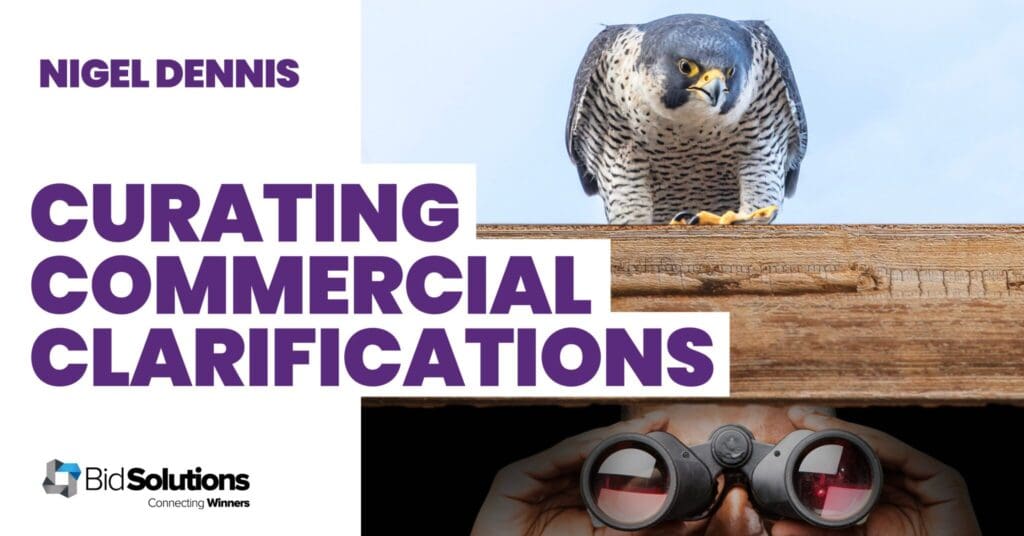“It all comes down to price”
This is a refrain we commonly hear from less experienced bidders.
First off, let’s set the record straight. Yes, price is an important factor for buyers. It’s also fair to say that some procurement processes homogenise qualitative responses to a point where it’s hard to see how anything other than the cheapest price will really matter.
But clearly this is not always the case. A quick read of almost any RFX document shows price is not the sole evaluation criterion. In most cases, non-price factors represent at least 50% of evaluation decision weighting. Some evaluation processes even try to remove price bias by running a ‘two envelope’ submission process whereby price and non-price responses are submitted separately.
So, how can you make sure the non-price related elements of your submission are relatable, believable and persuasive, rather than bland compliant answers that all but guarantee price will dictate the final award decision?
The answer is as old as the hills – storytelling.
Why does ‘once upon a time’ work so well?
If you need any convincing of the power of storytelling, look no further than Pixar Animation Studios. Pixar has used the same basic story structure across 22 feature films to date, winning 16 Academy Awards and amassing box office takings in excess of $US14 billion dollars for their endeavours.
Maybe storytelling in a business context is a bit over-hyped at present. But strip this away and you’ll find some very good reasons for its use, including:
1. Stories are familiar.
People have been using stories to communicate for thousands of years. Like a well-worn item of clothing, stories just feel comfortable. Story narrative structures like The Hero’s Quest, The Three Acts or Freytag’s Pyramid all share the basic pattern of a developing problem, rising tension and then resolution. Through countless exposure to this structure, we anticipate the journey we are being taken on, leaving us to focus on the story itself.
2. Stories have a real effect.
Neuroeconomist Paul Zak’s published research in Cerebrum shows that the various parts of a story form release a range of neurochemicals that lie behind the way we feel when exposed to stories. Story tension releases the stress hormone cortisol which creates attention and focus, whereas the resolution element creates oxytocin, the chemical that makes us feel good, promoting a sense of connection and empathy. A happy resolution also jumpstarts our limbic system, releasing dopamine which makes us feel hopeful and more optimistic.
3. Stories help carry the facts.
It’s no coincidence that the highly anticipated SuperBowl advertisements are mini-stories. Advertisers know that a bland portrayal of facts won’t trigger emotions. But wrap them up in a story and you’ll create attention, a sense of connection and importantly, a desire to act. As noted by Zak, “Narratives that cause us to pay attention and also involve us emotionally are the stories that move us to action.”
Storytelling can therefore be a powerful tool in the proposals world. The key is looking for opportunities to weave storytelling ideas and techniques into tender content, not just taking the storytelling concept at face value or always applying its entire form.
These storytelling ideas and techniques lie on a tactical to strategic continuum – presenting a fabulous persuasive palette to draw from.
Tactical storytelling can align the facts with your solution
Let’s start with tactical storytelling because it’s more concrete and easier to grasp.
- Tactical example #1. Substantiated claims tell a story, whereas claims without proof equals empty words. Statements like “Our state-of-the-art technology is the best on the market and will boost your productivity” are meaningless and will be read as such by evaluators. Using story principles, we can change this statement to “Over the last two years, we’ve worked with three similar organisations to yours who were experiencing productivity issues (problem). This was causing delays and frustration (tension) After implementing our platform, they’ve increased their productivity by an average of 24% (resolution)”.
- Tactical example #2. Common attachments such as CVs and case studies should be aligned to storytelling structures to help the reader understand their relevance and importance to your proposal. Just make sure you don’t lose the important facts within your eloquent flowing prose. We know that evaluators relate to stories, but key supporting information needs to be easy to find too.
If you need some case study examples, you can read BidWrite’s case studies here.
Strategic storytelling can lead the evaluators down the path to choose you
At a strategic level of storytelling, you’re focussed on the story behind your whole submission. This requires you to change from a micro to macro field of vision, ensuring that every element of your submission binds together to tell the story about how your organisation is uniquely placed to understand your client’s issues (problem), the frustrations caused by their current state (tension) and how you as the hero are uniquely placed to resolve them (resolution).
For example, a recent client was seeking to retain a multi-year contract to maintain and construct traffic signal infrastructure within a major Australasian city. Knowing that the City Council was keen to position itself as an early adopter of smart transport solutions, our client had worked hard over the previous five years to develop the requisite smart transport knowledge and capabilities. The central win theme chosen for the submission highlighted the fact that our client offered more than traffic signals construction and maintenance. They could in fact be a trusted advisor, offering proven expertise that could accelerate the City’s transition to smart transport technologies.
Every element of the submission was positioned to reinforce this fact. From the high-tech cover page and tightly focussed executive summary, to carefully selected projects and CVs demonstrating smart transport experience and expertise, the entire submission told the story that the Council wanted to hear. The submission showed evaluators that our client understood the Council’s issues and vision, could work with them to co-create a path forward, and provided real examples of what success looked like.
Despite knowing that they would not likely be the cheapest option, the cumulative effect of a well- constructed story built enough trust that our client was awarded a contract, with evaluators noting that our client’s non-price submission ranked top of the pile; a very satisfying result for all and practical proof that stories work.
The more you look, the more you’ll find
Once engaged with the idea of storytelling and with the right lens in place, you’ll see more and more opportunities to embed it within your tendering processes.
When used regularly, it will become easier to apply. In doing so, you’ll have unlocked a powerful and proven way to produce submissions that are highly contextualised to your buyer’s needs, based on a structure that carries evaluators to a position where it seems logical to select you.
It’s hard to imagine that such a simple idea can produce such outstanding results. But we know it works, and we urge you to try it.






